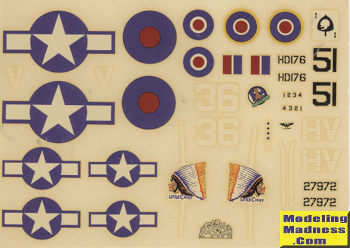
| KIT #: | JS-093 |
| PRICE: | $5.00 on the used kit market |
| DECALS: | Three options |
| REVIEWER: | Scott Van Aken |
| NOTES: | Original boxing (1974?) |

| HISTORY |
The P-47 was one of those aircraft that was initially not liked by fighter pilots. It was big, it was heavy, and it had really lame climbing performance. It was also not the best dogfighter around. This was especially the way the 4th fighter group felt when it transitioned from its nimble Spitfires to this 'behemoth'.
However, the Thunderbolt had several great qualities. One is that it could dive like no one's business, an attribute that helped many pilots who got into trouble with the enemy to disengage. Another was that it could take a lot of punishment. Thanks to the air cooled radial engine, it wasn't able to be knocked down by a single bullet through a coolant line. This made it perfect for ground attack and it was soon outfitted with wing bomb racks. It was with the tactical air force that the P-47 soon came into its own.
Early P-47s had the 'greenhouse type of canopy with a pointed windscreen that was not the best in terms of being able to see the bad guys. C models were short ranged and took forever to get to altitude as mentioned earlier. The D model improved things somewhat with a more powerful engine and while early Ds were not equipped with wing pylons for additional fuel or bombs, later versions were and this improved its abilities as an escort fighter as it was able to fly farther. However, it really meant more room for bombs.
| THE KIT |
The gear doors are not separate and need to be cut . There is no real wheel well
detail either, aside from a retraction strut molded into the inside of the upper
wing. The kit comes with a pair of bombs for the molded in wing racks, or you
can use the cylindrical 'paper' drop tanks that were used in Europe. One
thing that has plagued pretty much all the various pressings of this kit are
some sink marks on the wing. This kit has the full ailerons and flaps molded to
the upper wing halves. This makes for some rather thick plastic in the flap
areas. Even the initial pressings had sink areas on the upper and lower flaps,
so it is in your best interest to fill these if you are concerned.  This
is one of Hasegawa's first generation of engraved panel line kits. Typical of what you
find even today on Hasegawa 1/72 kits, there are decals for the instrument panel
and not much else in the way of detailing for the cockpit section. Sure, there
is a seat and instrument panel, that that is about it. It is very much a
transition kit and really can benefit from a replacement cockpit. Fortunately,
True Details does one at a very reasonable price. The canopy is a single piece,
but clear enough to see the interior fairly well.
This
is one of Hasegawa's first generation of engraved panel line kits. Typical of what you
find even today on Hasegawa 1/72 kits, there are decals for the instrument panel
and not much else in the way of detailing for the cockpit section. Sure, there
is a seat and instrument panel, that that is about it. It is very much a
transition kit and really can benefit from a replacement cockpit. Fortunately,
True Details does one at a very reasonable price. The canopy is a single piece,
but clear enough to see the interior fairly well.
 Instructions
on this one are all in Japanese, but easy enough to figure out. Markings are for
three planes. One is the now 'done to death' "Little Chief" that has been
included by pretty much every P-47D kit maker at one time or another. A second
is a red and red and white striped tailed plane from the 86th FG in unpainted
metal (you have to paint the stripes) while the third is a British Thunderbolt
Mk.I. in RAF colors from a training unit in Egypt. Kit decals may be usable, but
after all these decades, I wouldn't trust them. Lots of aftermarket out there
for you to choose from.
Instructions
on this one are all in Japanese, but easy enough to figure out. Markings are for
three planes. One is the now 'done to death' "Little Chief" that has been
included by pretty much every P-47D kit maker at one time or another. A second
is a red and red and white striped tailed plane from the 86th FG in unpainted
metal (you have to paint the stripes) while the third is a British Thunderbolt
Mk.I. in RAF colors from a training unit in Egypt. Kit decals may be usable, but
after all these decades, I wouldn't trust them. Lots of aftermarket out there
for you to choose from.
| CONCLUSIONS |
Despite its age, it is still a very nice kit. Tom Cleaver told me that these kits, which came out in the 1970s, were designed by the ex-Mania folks that Hasegawa added to their staff when they took over the company. If you recall, Mania kits had engraved panel lines, a trend that continues today. A bit of aftermarket and some filler work on those sink areas is all that is needed to make a very nice model.
September 2018
Copyright ModelingMadness.com. All rights reserved.
If you would like your product reviewed fairly and fairly quickly, please contact the editor or see other details in the Note to Contributors.
Back to the Main Page Back to the Review Index Page Back to the Previews Index Page